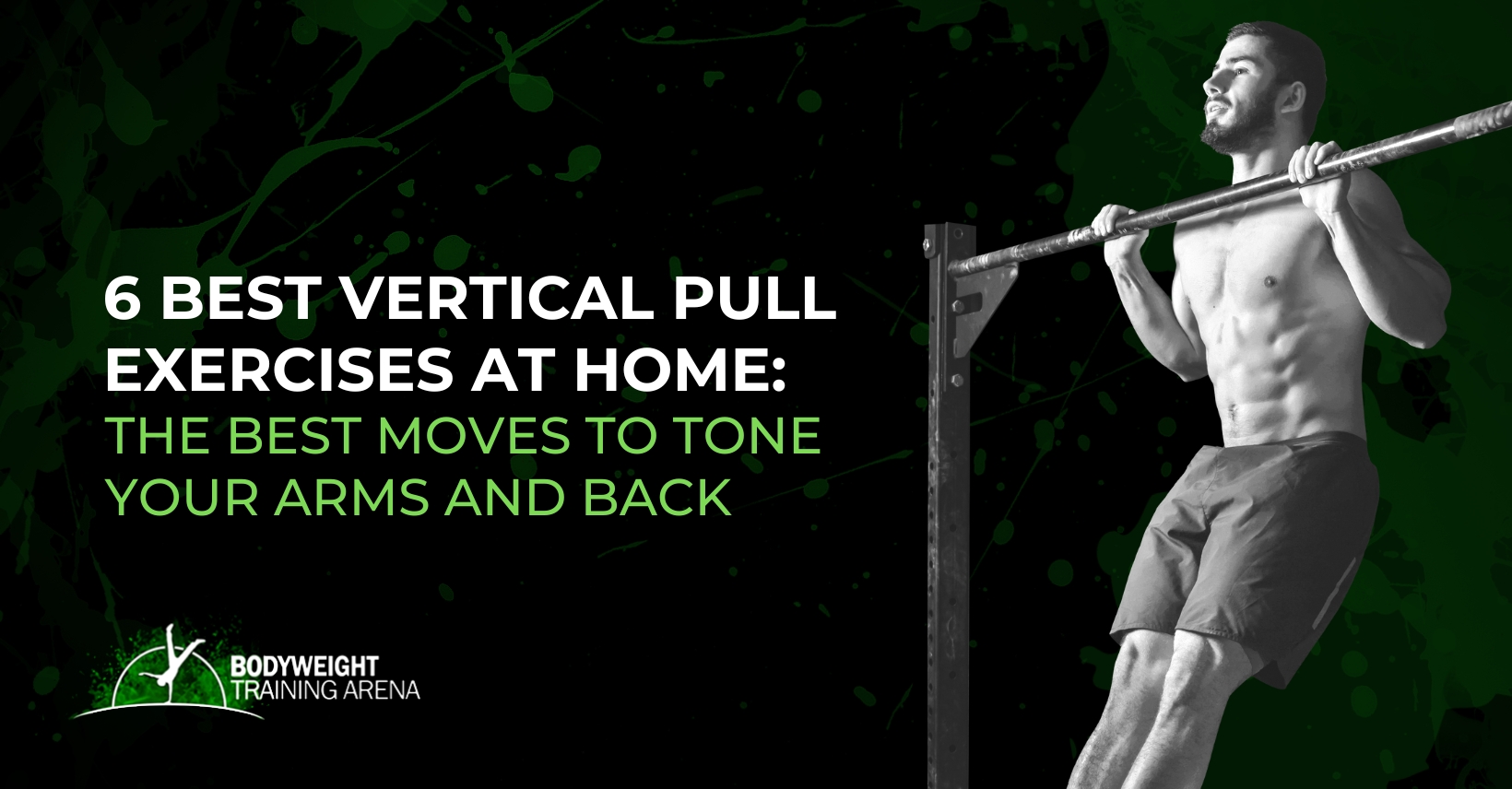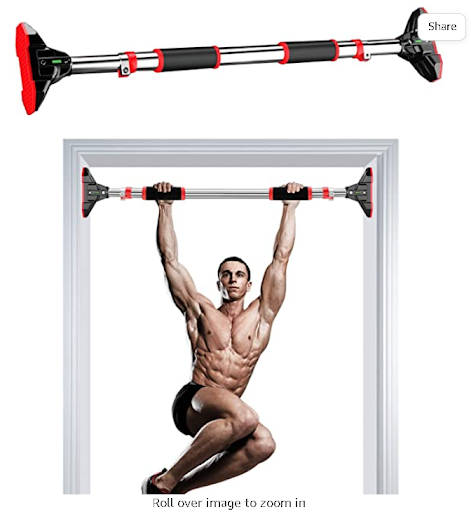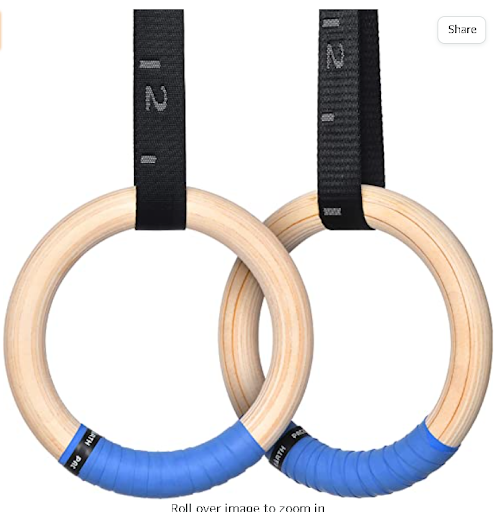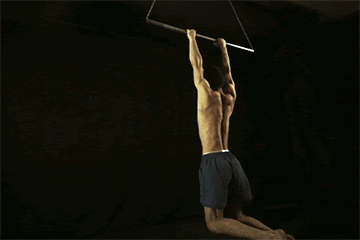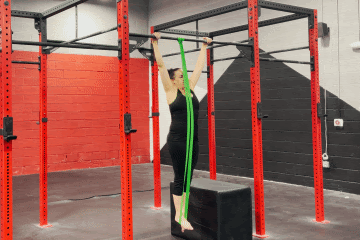Do you want to tone your arms and back without having to go to the gym? If so, vertical pull exercises are a great option for you. These exercises involve pulling your bodyweight up toward the ceiling, and they can be performed using a variety of different tools and equipment.
In this article, we will discuss:
- 👊 The best vertical pull exercises that you can do at home
- 👊 Benefits of vertical exercises
- 👊 Instructions on how to perform these exercises safely and effectively
- 👊 Frequently Asked Questions
If you’re ready to start developing your arms and back, keep reading!
🧐What are vertical pull exercises?
Vertical pull exercises are a type of strength training exercise that involves pulling your body weight up toward the ceiling. These exercises can be performed using a variety of different tools and equipment, including Resistance Bands, Pull-Up Bars, gymnastics rings, and TRX Systems. Vertical pull exercises are an excellent way to tone your arms and back, as well as improve your overall upper-body strength.
Vertical pull exercises primarily target the posterior chain or the upper back muscles which are:
- ✔️Latissimus dorsi also known as the “lats”
- ✔️Trapezius also known as the “traps”
- ✔️Rhomboids
- ✔️Rear deltoids
- ✔️Rotator cuffs
- ✔️Erector spinae
- ✔️And the biceps+forearms (although these are considered “front” muscles, this help facilitate pulling)
But since we’re covering the vertical pulls, these exercises tend to emphasize the lats.
🏆Benefits of vertical pulling exercises
There are many benefits associated with vertical pull exercises, including:
- ☑️Improves upper-body strength – These exercises’ main purpose is to develop stronger pulling mechanics by gradually loading your back (and bicep) muscles.
- ☑️Develops arms and back muscles – Along with the strength gains comes the potential of 📍building bigger muscles. If the intensity and training volume are adequate, expect muscle growth.
- ☑️Increases muscle definition – General fat loss is facilitated with additional pulling exercises. Together with muscle growth, muscle definition can be more visible thanks to fat loss due to increased caloric expenditure from your training.
- ☑️Improves posture – Research shows that implementing general strengthening exercises, including back development, improves posture.
- ☑️Reduces risk of injuries to the shoulders and back – Because of a posterior chain that’s more capable of movement, the back and shoulders are less prone to getting injured due to overexertion.
- ☑️Alleviates and prevents back and shoulder pain – Back exercises address aches and pains coming from weaknesses that developed into dysfunction. Read more here: 📍How to Treat Injuries with Calisthenics
✅What equipment do I need for vertical exercises?
You can choose among the three below:
-
Pull-up bar
-
Gymnastics rings
-
TRX system
A pull-up bar offers the best strength output. This is because it’s stable and you can easily exert force on the bar and lift yourself up. With rings and a TRX system, you will need some stabilization. This isn’t necessarily a bad thing since you can get stronger through this method, but for beginners, we recommend the pull-up bar.
In general, use what you have access to. Even if just a tree branch or a sturdy house beam in your garage.
Read more: 📍Gymnastics rings vs Pull-up Bar
✨5 Vertical Pull Exercises At Home
🔥Scapula pulls
Every vertical pulling exercise starts with the same motions. It begins from a dead hang with the shoulders shrugged towards the ears then the shoulders are pulled down away from the ears (depression) and the shoulders blades are pinched together (retraction). These motions are crucial for stabilizing the shoulder joints while maximizing the pulling capacity of the back muscles.
You can’t get stronger with vertical pulls if you’re not strong with shoulder depression and scapula retraction.
So how do we improve this? By training the scapula pulls. The scapula pulls train the first part of any vertical pull only. Although the movement seems minimal, the motion isn’t easy especially when you’re holding your full body weight. This is a must-have exercise for stronger pulls and also assists in improving your general back muscles.
🎯How to perform:
- Hang on a bar with hands shoulder-width apart and palms facing forward.
- Depress your shoulders.
- Retract your scapula.
- Hold briefly the position.
- Lower down with control.
- Repeat the motion for reps.
✊Coaching pointers:
- Maintain straight arms so don’t bend your elbows
- Move through your capable range of motion
- Core engaged
🔥Pull-ups
Pull-up is the king of lat-building exercises. It primarily targets the latissimus dorsi (lats) with the assistance of other back muscles. The vertical pull movement recruits more muscles than any other back exercise which is why it’s considered a compound movement.
🎯How to perform:
- Begin with a dead hang with palms facing down.
- Depress and retract your scapula.
- Pull your body until your chin is over the bar.
- A brief pause at the top.
- Lower down with control.
- Repeat for reps.
✊Coaching pointers:
- Posterior pelvic tilt – hips tilted backward
- Core engaged
- Depress and retract your shoulders upon initiating movement
- Elbows close to the body
- Imagine driving your elbows towards your hips then back
- Neutral head position
- Overhand grip
🔥Chin-ups
With a small shift in grip orientation, the supinated grip forces you to engage your biceps to facilitate the chin-up motion. This makes chin-up a core exercise for building bigger biceps muscles.
Check this out: 📍Best Calisthenics Bicep Workout
More people find pull-ups easier because of the additional bicep assistance instead of pulling more with just your lats and other back muscles like from pull-ups. However, chin-ups require good overhead shoulder mobility & forearm supination. Address this concern and progress gradually to avoid elbow pains and shoulder pains with chin-ups.
More help here: 📍How to Avoid Golfer’s Elbows from Chin-Ups
🎯How to perform:
- Begin with a dead hang with palms facing you.
- Depress and retract your scapula.
- Pull your body until your chin is over the bar.
- A brief pause at the top.
- Lower down with control.
- Repeat for reps.
✊Coaching pointers:
- Posterior pelvic tilt – hips tilted backward
- Core engaged
- Depress and retract your shoulders upon initiating movement
- Elbows close to the body
- Imagine driving your elbows towards your hips then back
- Neutral head position
- Underhand grip
🔥Neutral grip pull-ups
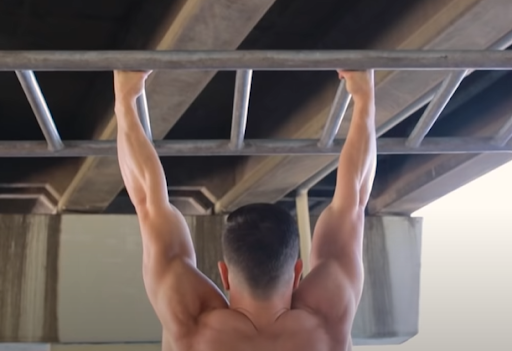
Source: FitnessFAQs
The neutral grip pull-up is a vertical pull that targets the lats similarly to the overhand grip pull-up and chin-up. The biggest difference is that you’re not engaging your biceps with a supinated or requiring more overhead mobility with a pronated grip which makes this exercise an excellent lat builder. This grip requires the least shoulder mobility among the two previously mentioned pull-up grips.
The downside of neutral grip pull-ups is the accessibility of neutral grip. Not all pull-up bars offer a neutral grip. If this is the case, you have to be more creative like using towels or using a pair of gymnastic rings to get your hands in a neutral position.
🎯How to perform:
- Begin with a dead hang with palms facing each other.
- Depress and retract your scapula.
- Pull your body until your chin is over the bar.
- A brief pause at the top.
- Lower down with control.
- Repeat for reps.
✊Coaching pointers:
- Posterior pelvic tilt – hips tilted backward
- Core engaged
- Depress and retract your shoulders upon initiating movement
- Elbows close to the body
- Imagine driving your elbows towards your hips then back
- Neutral head position
- Neutral grip
🔥Band assisted pull-ups
While these vertical pulling exercises look easy and simple, they can be technically demanding especially for beginners who don’t have the adequate requirements (particularly STRENGTH) to perform pull-ups.
Performing pull-ups incorrectly can come from two things. It’s either you’re not aware of the proper technique and form OR you’re simply not strong enough to perform the movements. This is why many beginners (or even experienced athletes) still commit 📍common pull-up mistakes.
To avoid the mistakes above, regress into an easier pull-up variation such as the band-assisted pull-ups. This set-up allows consistent assistance throughout your sets but you can also do a leg-assisted variation if you don’t have access to a good set of resistance bands.
🎯How to perform:
- Set up the band and anchor it on the pull-up bar.
- Perform a dead hang and shoot a leg into the bar.
- Pull your body until your chin is over the bar.
- Lower down with control.
- Repeat for reps.
✊Coaching pointers:
- Use the least band assistance that will help you perform the minimum number of reps required.
- When getting off the bar, slowly push the band down with your hands and gently release it to avoid recoil
- Follow the regular pull-up technique
🤔Frequently Asked Questions:
🔎Which grip orientation is the best for pull-ups?
There’s no overall best pull-up grip. The pull-up, chin-up, neutral grip, mixed grip (implementing multiple grips), towel grip, or even false grip pull-up (the muscle-up grip) all offer their own advantages and purpose.
Let’s summarize them for you:
- Pull-up (overhand/pronated grip) – maximized lat and trap activation
- Chin-up (underhand/supinated grip) – emphasized bicep activation
- Neutral grip pull-up – shoulder-friendly & forearm activation
- Mixed grip – depends on the combination but offers multiple benefits
- Towel grip – More forearm and bicep activation
- False grip – Better translation to muscle-ups
All exercises offer a good dose of general strength development for your lats and back muscles. Choose which fits your goals, needs, and current skill level.
Read more: 📍What is The Best Pull-up Grip
🔎What is the best width for grip stance for pull-ups?
For most back activation, the shoulder width or slightly wider than shoulder width offers the best solution. Going too wide can limit your range of motion of elbow flexion. Going too narrow shifts the emphasis unto your forearms and biceps which isn’t our goal.
We recommend checking out the shoulder-width stance or slightly wider than that depending on your body’s proportions and response.
🔎Is neck pull-ups safe?
The answer is: it depends on your current strength level and shoulder mobility. The behind-the-neck pull-ups require a high level of shoulder external rotation and abduction. When loaded, this can be dangerous for the untrained. However, all exercises can be said dangerous if you’re body is not prepared to do the movement.
Neck pull-ups are reserved for those who are trained to do them. Don’t randomly attempt them if you did not work on their regressions (band pull-downs, leg-assisted variation).
🔎Can I do pull-downs instead of pull-ups?
While you can get stronger and bigger lats with lat pull-downs, a muscle-activation research analysis revealed that doing pull-downs doesn’t necessarily translate to pull-ups due to the difference in core activation and overall body engagement. The pull-up is a complex movement that requires full body tension. Although there are certain emphasized muscle groups, it requires good body control and full body activation to fully engage.
Yes, you can perform pull-downs especially if you want to build bigger muscle thanks to the “isolation” component, but for strength, we have to recommend opting for pull-ups and their more advanced progressions.
🔎Can I do pull-ups on gymnastics rings?
Yes! Beginners may find it more difficult to hold onto a pair of rings at the start of the journey because of the circular shape. However, pull-up on rings is amazing because your shoulders and elbow joints can move freely unlike when doing pull-ups on a bar where your joints move at a fixed angle. This minimizes the risk of joint pain so you can do more reps over the course of your training journey.
In addition, your pull-up grip orientation is more flexible so you can easily adjust according to your needs and goals.
📌Takeaway
Performing vertical pulling exercises is the best way to develop a strong and muscular back and arms. These exercises can be done at home with little to no equipment required.
There are many different types of vertical pull exercises, so choose the ones that best fit your goals and current skill level.
Be sure to warm up properly before attempting any of these exercises and always use proper form to avoid injury. With consistency and dedication, you will see results in no time!
If you’re looking for a way how to implement these exercises, we highly recommend checking out the article below:
📍The Best Calisthenics Pull Workout
We hope enjoyed this short read!
What’s your favorite vertical pull exercise?
Let us know in the comment section below your thoughts.

